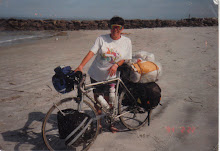When it comes to written technical communication, after 25 years' work as a technical editor, I'm a stickler for punctuation, usage, grammar, expression of units of measure, logical organization.
Not so strict am I on spoken communication; in fact, the regionalisms which make other editors cringe I find delightful and amusing. A favorite East Texas quirk is the use of the present, instead of past, tense. (He run a V-8 Ford. They come south from Tennessee in 1930.)
And I never adhere to the stilted-sounding, "He is taller than I [am]." I've even been known to use a preposition to end a sentence with in colloquial spoken English.
Grammar Girl, what do you think of all this?
But, logically, English really needs a second-person plural pronoun to correlate with
vous in French, and
Ustedes in Spanish. Okay, OED, Texas has solved the problem. I'm talking about
y'all. So much more elegant than the Brooklyn
you guys, or the misguided
youse guys, so much more efficient that
you people. What do Midwesterners use? I'd like to know, ubetcha.
Another word to add to the lexicon:
ain't. We say
I am not. For the contraction, we say
I'm not, not
I amn't. And inverted for the interrogative, it becomes
Aren't I?
Solution: I propose
ain't as the contraction for
am not. The machine stenography language used by court reporters has a code for ain't. Ain't it logical that written English should follow suit?
A couple of very common errors. In my experience, the most commonly misspelled word is accommodation. Notice that the root is the same as that of commode.
Imply/infer: Infer is not a fancy way of saying imply. The speaker implies; the listener infers.
Compose/comprise: A whole
comprises (not
is comprised of) its parts. Parts
compose the whole.
Fewer/less: If an amount is quantifiable, a smaller amount is denoted as fewer, not less. For instance. "He has enjoyed fewer than 25 lattes in this Starbucks." If the amount is more bulk-y in nature, less is fine: There's less whip on this specialty drink today than last week."
Continual/continuous: Continual has more of a recurring connotation, while continuous means uninterrupted.
Decimate literally means to reduce by one-tenth, not to obliterate, but "its English meaning has been intended to include the destruction of any large proportion of a group." [Webster's II New College Dictionary]
Segueing into
spelling out of numbers. In ordinary text, according to the venerable
Chicago Manual of Style, numbers one through ninety-nine are spelled out, as well as any number followed by "
hundred, thousand, million, etc."
On the other hand, in technical text, depending on the style of the journal, usually numbers 10 and below are spelled out when not denoting units of measure. Units of measure are always spelled out. Beginning a sentence with a number above 10? Recast the sentence to avoid the problem entirely in technical writing.
Engineers and physicists know this one. If a unit of measure is less than one, a zero precedes the decimal point (0.3 kilometers), but not if the unit is never expressed as other than a fraction, such as some statistical terms. The reason for the zero: to take the place of an integer (and maybe to assure readers that the integer was not unintentionally omitted.)
Hyphen,
en-dash, em-dash: A hyphen, simply puts, makes one word out of two (high-flying acrobat). An en-dash (alt+numpad 0150)usually expresses an time interval (serving as president from 2000–2005). An em-dash (alt+numpad 0151), which has no spaces before or after, usually serves to set off a parenthetical: His Colonial-era farmhouse—built as a munitions depot—was in need of repair. It can also introduce a bulleted list, serving a similiar function to that of a colon.
Years of experience and months of pregnancy or anything that is a measure
of something is expressed as a possessive: eight months' pregnant; 15 years' experience. (Note that these are plural possessives.)
Any editors out there have other observations to share? I would love to compile and include in a future entry.
Next time, some word processing tips.
 Very early the previous morning of December 10, 2008, the Brazos Valley was blanketed by a sleet storm. Then, that afteroon, snow, in big accumulations of flakes, fell on the Brazos Valley—and even upon Houston, Texas. Most students at Texas A&M University had never seen snow on the campus. Many snowmen lived for a day, until temperatures in the 60s took their toll. Cars (see photo) drove around with miniature snowman mascots.
Very early the previous morning of December 10, 2008, the Brazos Valley was blanketed by a sleet storm. Then, that afteroon, snow, in big accumulations of flakes, fell on the Brazos Valley—and even upon Houston, Texas. Most students at Texas A&M University had never seen snow on the campus. Many snowmen lived for a day, until temperatures in the 60s took their toll. Cars (see photo) drove around with miniature snowman mascots. Students—even graduate students—frolicked in the snow.
Students—even graduate students—frolicked in the snow.












